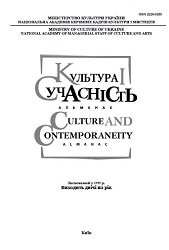Культуротворчий потенціал архаїзації візуальності: образотворення, режими бачення, практики
The Cultural-creative Potential of Archaization of Visuality: Creation of Images, Vision Modes, Practices
Author(s): Oksana Anatoliyivna PushonkovaSubject(s): Media studies, Aesthetics, Culture and social structure , Sociology of Culture
Published by: Національна академія керівних кадрів культури і мистецтв
Keywords: visuality; visual culture; archaization; aesthetic practices; creation of images; modes of vision;
Summary/Abstract: The purpose of the article. Research of cultural features of archaization of visuality in the context of modern creation of images which leads to the emergence of new aesthetic practices and modes of vision. The research methodology consists in the application of systematic, axiological and cultural-philosophical approaches, as well as communicative and hermeneutical methods to understand the characteristics and strategies of interpretation of visual practices in the context of modern culture. The scientific novelty lies in the attempt to determine the cultural role of archaic visual practices in the syncretism of the latest media. Conclusions. New functions of perception and vision are emerging in the new media reality. The idea of expanding the media correlates with expanding perception. The emphasis in modern research is on the dynamic aspects of the vision and configuration of aesthetic experience, of which the media are an integral part. Going beyond the paradigm of ocular-centrism determines the research attention to the dimensions of procedural and archaic elements of visual thinking. This makes it possible to consider the visuality in the trends of simplification and complexity of the image in the latest aesthetic practices that set new modes of vision. Procedural, ambivalence, amodality, simultaneity, permanence of vision, variability of its angles («vision from the inside», asymptotic, lateral, branched vision), on the one hand, are evidence of regression of the «smart eye», on the other – contain powerful cultural potential, which allows to restore the forgotten synergy of person with the world and the foundation of the practice of creation of images from primary sensations. In the age of nanotechnology, the basis of new vision modes is the threshold or boundary between different media formats, which allows overcoming the sharp transitions of scaling and switching. This is due to the establishment of balance: a constant process of creative renewal, expression and dynamics when the whole changes in the process of formation. Due to the actualization of simplified archaic forms, the complexity of the visual model of culture and identity is balanced.
Journal: Культура і сучасність
- Issue Year: 2022
- Issue No: 1
- Page Range: 62-69
- Page Count: 8
- Language: Ukrainian

